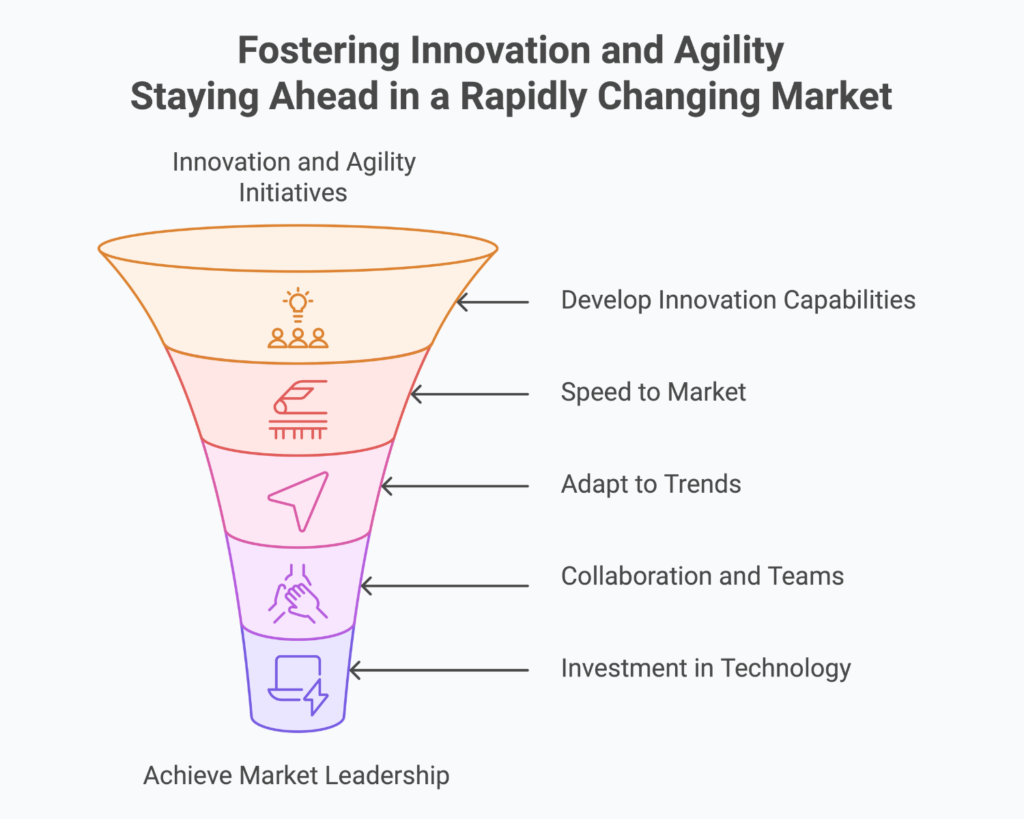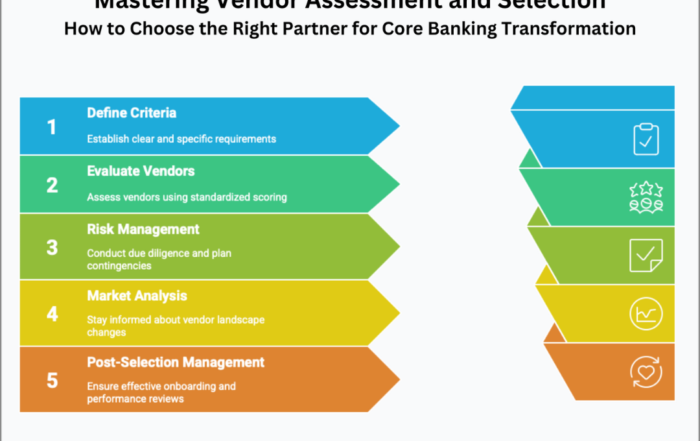
Unlock your bank’s potential with innovation and agility to drive successful core banking transformation, stay competitive, and meet evolving customer needs.
TL;DR – Fostering Innovation and Agility: Staying Ahead in a Rapidly Changing Market
- Embrace a Growth Mindset – Encourage continuous learning and adaptability to drive innovation.
- Leverage Technology – Utilize AI and automation to enhance efficiency and responsiveness.
- Promote Cross-Functional Collaboration – Break down silos to facilitate diverse perspectives and creative solutions.
- Implement Agile Methodologies – Adopt flexible frameworks to swiftly respond to market changes.
- Invest in Continuous Learning – Provide ongoing training to keep teams ahead of industry advancements.
By focusing on these strategies, organizations can enhance their innovation capabilities and maintain a competitive edge in dynamic markets.
Have they ever wondered why some banks seem to thrive with the times while others are stuck so far behind?
I once spoke with an executive from a traditional bank who couldn’t fathom how, with all resources available, they were still behind every small fintech startup. And what was their problem? The culture of innovation and agility needed to be included.
Innovation and agility are the core banking transformations in today’s fast-paced financial world. They are not mere buzzwords to keep them competitive but the essential elements that will make a difference if one wants his core banking transformation to be more than an upgrade. In this article, we discover why these elements are essential and how to make them happen within your organization to keep you ahead of the pack.
Understanding Innovation and Agility
Innovation is the art of generating new ideas, products, or methods to implement, creating value for the organization. Agility can be understood as the capability of moving with speed, effortlessly changing to meet the new demands of your environment.
Why Do They Matter?
Think of the financial services industry as a river with rapid currents flowing. Innovation and agility are the paddles that enable your organization to handle these currents. Without these, you risk the following:
- Missing Opportunities: Slow adaptation prevents your organization from being as swift as its competitors.
- Customer Dissatisfaction: Inability to meet customer expectations results in less loyalty and a damaged reputation.
- Operational Inefficiencies: Holding on to obsolete processes hinders a company from fully exploiting new technologies and, therefore, from being competitive.
But for organizations that focus on innovation and agility:
- Market Leadership: They create trends rather than merely follow them.
- Delight Customers: They regularly provide state-of-the-art services that never disappoint but surprise expectations.
- Improve Efficiency: They enhance operations through better technology usage and simplifying processes.
Critical Factors of Innovation and Agility
If you want to instill innovation and agility in your company, pay attention to the following areas:
1. Innovation Capabilities
Develop an innovation capability-building for continuously creating and installing new ideas that keep one ahead of the crowd.
- Creative Thinking Development: Provide a channel for employees to talk out loud despite the idea being out of the box. The idea is to make it a safe place for them to think out loud.
- R&D Investment: Converse with the resources to find new technologies and solutions.
- External Partnerships: Partner with fintech, universities, or innovation hubs to stay ahead.
2. Speed to Market
Implementing new products and services quickly to customers is crucial for sustainable competitiveness.
- Streamline Processes: Reduce the bureaucratic red tape that delays decision-making.
- Agile Methodologies: Using frameworks such as Scrum or Kanban to bring efficiency to projects.
- Empower the Teams: Give teams the power to make decisions and act fast.
3. Adaptability to Trends
One must keep one’s finger on the pulse of industry trends to change course if necessary.
- Market Monitoring: Analyzing market data and customer feedback from time to time to stay updated.
- Stay Flexible: Be willing to alter plans whenever new information crops up.
- Continuous Learning: Embed a culture of constant learning and development of new skills.
4. Collaboration and Cross-Functional Teams
Innovation often sparks at the intersection of diverse perspectives and expertise.
- Break Down Silos: Direct Collaboration of people across departments.
- Create Diverse Teams: Teams comprising people from different walks of life ensure innovative ideas.
- Open Communication: Create an environment where communication can flow freely and where each voice is heard.
5. Investment in Emerging Technologies
Being one of the early adopters of new technologies in advance while it is at its birth stage will give you a competitive edge.
- Create Technology Roadmaps: Create roadmaps that consider your strategic plans so that you work towards adopting technology in due time.
- Pilot Programs: Begin small-scale piloting of any new technology before its full-scale deployment.
- Vendor Relationships: Engage with technology vendors to stay on top of upcoming trends and technologies.
Best Practices to Drive Innovation and Agility
Following are some practical recommendations that will help an organization become more innovative and agile:
1. Cultivate an Innovative Culture
- Leadership Buy-In: The leadership should lead from the front in innovation, whereby leaders show that innovation is critical through actions.
- Recognition and Rewards: Recognize employees for their innovative ideas or agility.
- Fail Forward: Encourage calculated risks; don’t treat failures as failures but instead as learning curves.
2. Implement Agile Frameworks
- Agile Training: Train your teams in agile methodologies.
- Iterative Development: Divide projects into small pieces of work to deliver results faster.
- Regular Feedback Loops: Establish an ongoing feedback circle to iterate products and processes.
3. Invest in Technology Infrastructure
- Modernize Legacy Systems: Refresh outdated systems that keep businesses from being agile and innovative.
- Adopt Cloud Solutions: Avail cloud services for scalability and flexibility.
- Leverage Data Analytics: Make smarter decisions faster with big data and analytics.
4. Encourage Collaboration
- Create Innovation Labs: Design dedicated spaces for Collaboration, co-creation, and problem-solving.
- Cross-Departmental Projects: Provide projects that involve information from different areas so that they can produce multi-dimensional thinking.
- Employ Collaboration Platforms: Employ Slack or Microsoft Teams, among other real-time communication platforms.
5. Stay Customer-Centric
- Customer Feedback: Request customer feedback on many occasions and take specific actions.
- User-Centered Design: Engage in product and service development, keeping the end-user in mind.
- Personalization: Draw upon data insights to craft experiences for specific customers.
The Impact on Transformation Success
Innovation and agility focus more on the priorities of either or ramping up your transformation efforts, including:
- Accelerated Growth: Innovative products and services open new revenue streams.
- Improved Efficiency: Agile processes eliminate waste and streamline operations.
- Competitive Advantage: Leading the trends positions your organization as an industry leader.
- Employee Engagement: A dynamic environment attracts top talent and boosts morale.
On the other hand, poor innovation and agility may lead to:
- Stagnation: Lack of evolution can make an organization outdated.
- Competitive Disadvantage: Competition may know something more innovative and snatch your market share.
- Customer Attrition: Services grow old, and soon, customers may start searching for modern alternatives.
A Story of Transformation
Remember that old conventional bank I told you about some time back? Well, when the convention realized how unprogressive they had been, that convention became a strategy. By creating an innovative culture across all levels, assembling cross-functional teams of innovators, and making smart investments in emerging technologies such as AI and blockchain, they were able to develop new products to appeal to this tech-savvy customer. The agile methodologies unlocked even quicker ways for them to take those products to market. The result? Instead, they not only caught up with their fintech competitors but even began leading the charge in many ways.
Moving Forward
Innovation and agility aren’t just nice-to-haves—they’re essential for a successful core banking transformation. By fostering a culture that values new ideas and can adapt quickly, your organization can confidently navigate the ever-changing financial landscape.
Remember, it’s not necessarily the biggest or the most vital organizations that thrive but those that can best adapt to change.
Your Next Steps
Ready to assess your organization’s innovation and agility? Our Core Banking Transformation Readiness Assessment can help you identify areas where you excel and where there’s room for improvement.
Found this article interesting? Check out these three related reads for more.
- The Ultimate Guide to Core Banking Transformation Readiness
- Maximizing Technology Stack Compatibility: Building a Foundation for Seamless Transformation
- Enhancing Operational Efficiency: Streamlining Processes for Optimal Performance
#CoreBankingTransformation #CoreBankingReadiness



